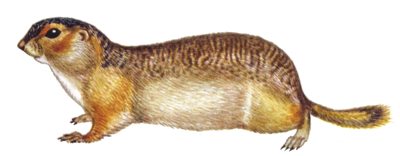Pests
Citellus (Colobotis) major Pallas, 1778. - Hibernating Large Ground Squirrel; Large-Toothed Souslik; Russet Ground Squirrel.
Systematic position.
The class Mammalia, order Rodentia, suborder Sciuromorpha, family Sciuridae, subfamily Marmotinae, genus Citellus, subgenus Colobotis. The species includes 3 recognized subspecies.Biological group.
Rodent pests.Morphology and biology.
Body length, up to 340 mm; tail length, up to 105 mm (usually 24-40% of body length). The dorsum coloration is dark, ochre-brownish, mottled with light ochre hair-tips, forming intensive spots, sometimes turning into mottling. Top part of head and nose bridge are silvery-grayish. Reddish or brown spots are on cheeks and under eyes. Tail tip with light marginal limb; the tail is reddish from below. Diploid set of chromosomes: 36. Inhabits plain and sub-mountain steppes (up to 500 m a.s.l.), cereal and motley grass steppes. Penetrates along steppe districts into forest-steppe and southern parts of forest zone; along river valleys and into semi-deserts. Settles on slopes of ravines, on road sides, pastures, uncultivated lands, and on sowed lands. Burrows, as with other rodents, are of two types; permanent (vertical) and temporary (slanting) ones. Permanent burrows are 100-120 cm in depth, and the total length of underground passages is 2 to 2.5 m. Temporary burrows are not as deep and are more simply constructed.Distribution.
Within the territory of the former Soviet Union it is found in the Trans-Volga region (Samara and Orenburg Regions), in Northern and Western Kazakhstan (Ural, Aktyubinsk, Kustanai and Tselinograd Regions), in the South Ural.Ecology.
Daily activity is two-phase, being most pronounced in adult and older individuals during hot seasons and in southern part of area. Young rodents are active for most of the day, having no break in midday hours. Winter hibernation lasts about 6.5-8.5 months. Dates of awakening depend on spring conditions and may vary by 20-25 days. The Large-Toothed Souslik differs from other rodents in high mobility. In dry periods the rodents walk away from permanent holes searching for fodder traveling distances up to 300 m or more. Swims well and on the whole, could swim across such rivers as Ural River. Vegetative fodders are predominate in food ration, including 32 to 52 species of herbaceous plants; the rodents feed on upper root parts of plants and on bulbs in spring, then move to flowers and leaves; grain-crops are eaten during the developmental stages of milky and waxy ripeness. Also eats meat, but it is not as important as for the Long-Tailed Ground Squirrel. Intensity of reproduction is comparatively high; pregnancy lasts approximately 23 days; an average number of young animals is usually 7-8 in a brood. At the age of 2.5 months the individuals reach the same size as adults, weighing 500-570 g. Population dynamics is characterized by sudden fluctuations; periods of mass reproduction are replaced by deep depression times, when single animals remain in settlements. The main factors of population reduction include plowing of virgin and long-fallow lands (main areas and habitats of rodents. reservation), regular destructive measures on large areas, and deep soil penetration of frost during hibernation, also predatory birds and terrestrial predators, epizootics.Economical importance.
Harmful pest of cereals (wheat, rye, millet). Greatly thins out sowing crops, entirely destroying them in some places by digging out sown seeds and eating shoots. Also damages sugar-beet and protective forest shelter belts, especially oaks by digging out acorns. On pastures the rodents change the species structure of fodder crops by eating the most valuable ones. The active digging activity results in changing soil chemical structure and in soil pickling. Natural carrier of plague and rabbit-fever infection. Minor object of fur trade.Reference citations:
Bazhanov V.S. 1948. Contemporary distribution and history of Big Souslik (Citellus major Pall. 1770). Izvestiya AN KazSSR. Zool., 63(8): 27-50. (In Russian)Bazhanov V.S., Erofeev P.V. 1932. Reddish Souslik and methods of rodent control. Moscow-Samara. Sredne-Volzhskoe Publishing House. 48 pp. (In Russian)
Gromov I.M., Bibikov D.I., Kalabukhov N.I., Meyer M.N. 1965. Terraneous Marmotinae. Fauna SSSR. Mlekopitayushchie. Moscow, Leningrad: Nauka. V. 3(2): 467. (In Russian)
Gromov I.M. Erbaeva M.A. 1995. Mammals of Russia and adjacent territories. In: Aristov A.A., Baranova G.I., eds. Lagomorphs and rodents. Issue 167. St. Petersburg: ZIN RAN. 522 pp. (In Russian)
Tikhvinskii V.I. 1932. Biology of Reddish Souslik (Citellus rufescens Keys. et Bias.). Trans. of Kazakhstan University, Kazakhstan, 92(7-8): 46-89. (In Russian)


